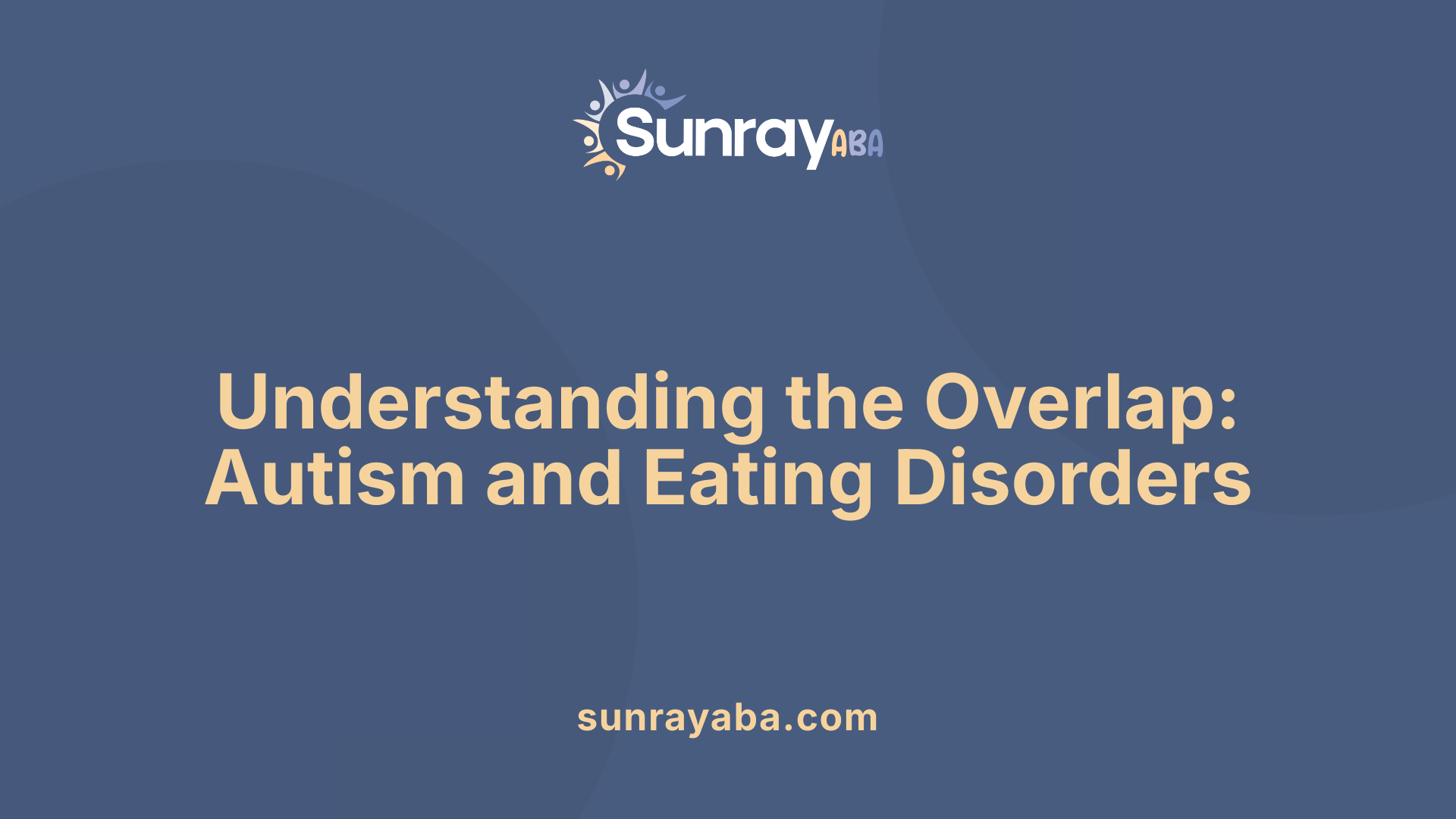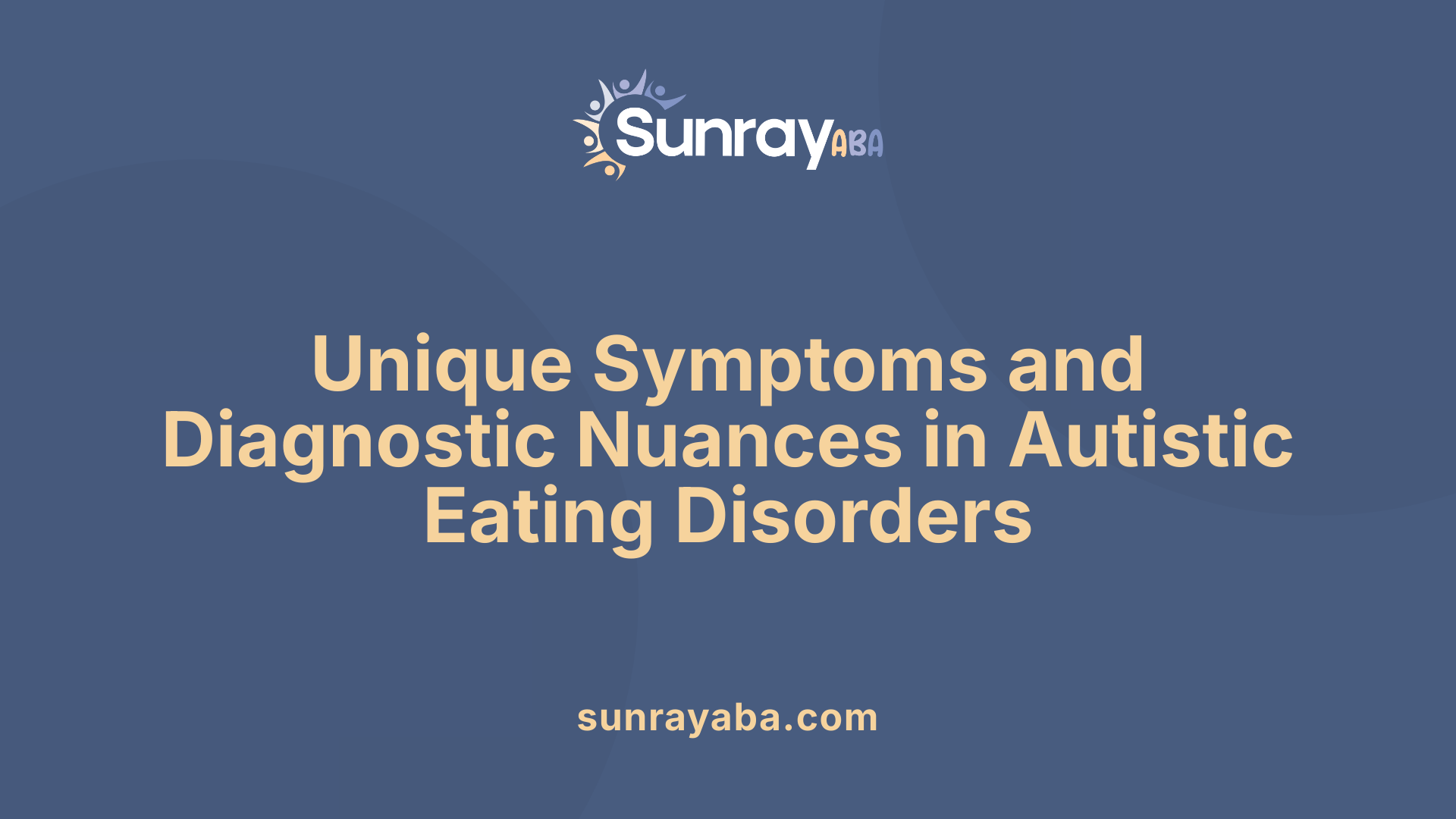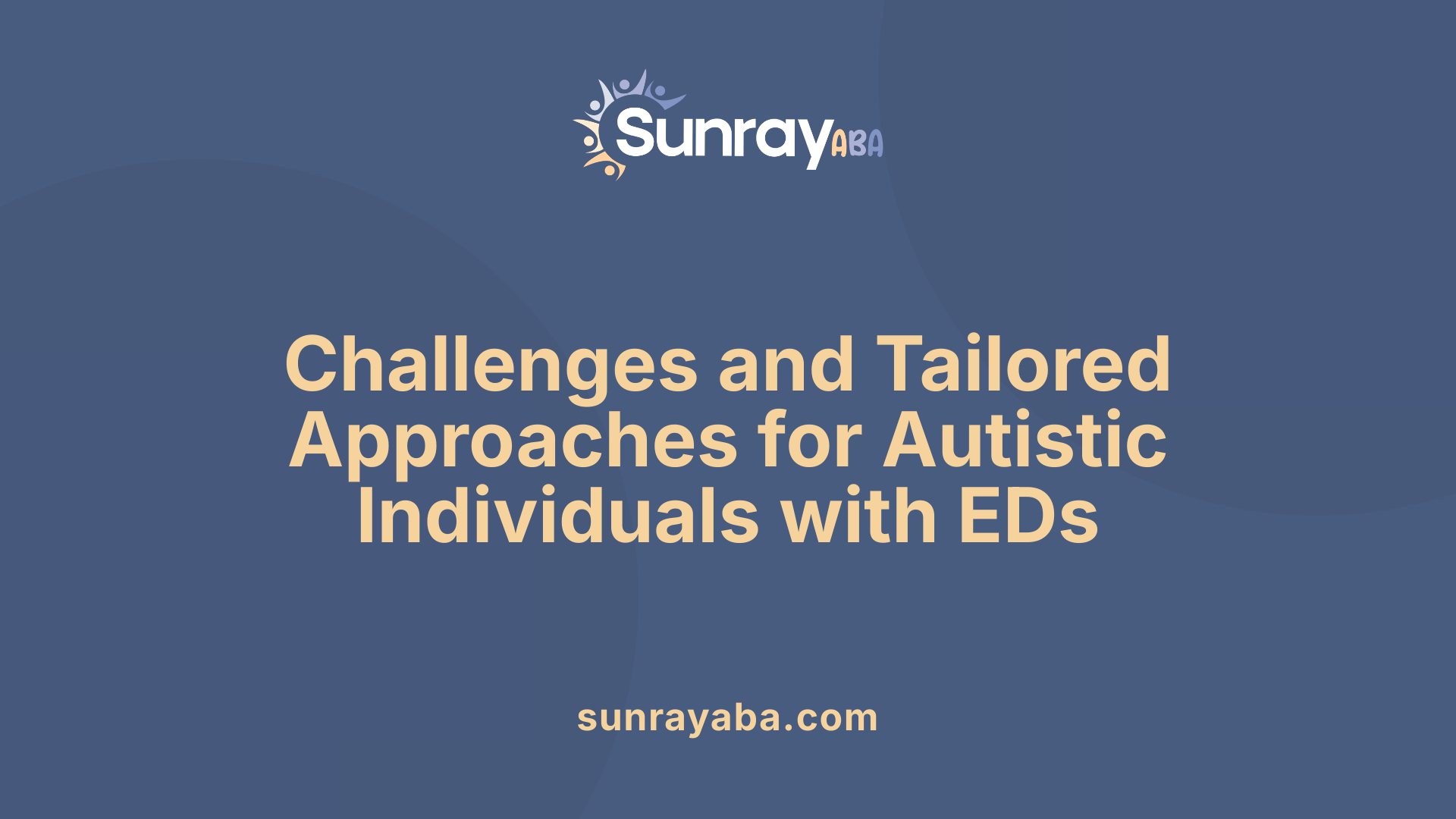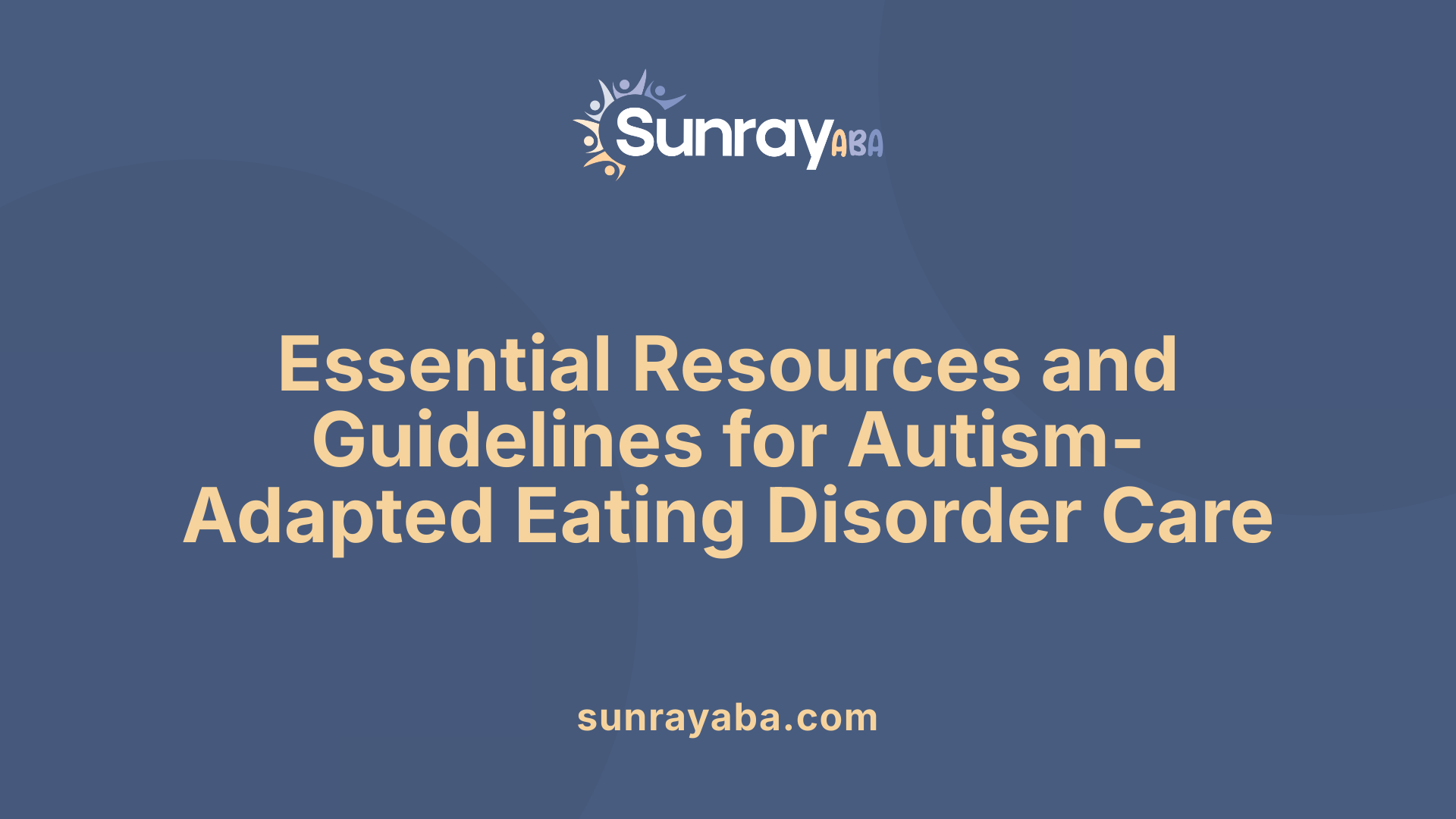Eating Disorders And Autism

A Critical Overview of Autism and Eating Disorders
Eating disorders and autism spectrum disorder (ASD) often co-occur, creating complex diagnostic and treatment challenges. Recognizing the unique signs, underlying mechanisms, and effective support strategies is vital for healthcare providers and families. This article synthesizes current research, clinical experiences, and available resources to provide an in-depth understanding of how autism relates to eating disorders, emphasizing the importance of tailored approaches for better outcomes.
Prevalence and Shared Features of Autism and Eating Disorders

What is the relationship between autism and eating disorders?
Research indicates a significant and complex relationship between autism and eating disorders, with many autistic individuals experiencing atypical food preferences, sensory sensitivities, and ritualistic eating behaviors that can increase the risk of developing conditions like ARFID and anorexia nervosa.
Studies estimate that between 4% and 23% of people with an eating disorder are also autistic, highlighting a notable overlap. For women, the numbers are particularly striking: around 20-35% of women with anorexia meet the criteria for autism, and additional research suggests that approximately 20-30% of adults with eating disorders share autistic traits.
Statistics on co-occurrence rates
| Population Group | Percentage with Autism or Traits | Additional Notes |
|---|---|---|
| Women with anorexia | Up to 35% | Many may also meet criteria for ARFID; early diagnosis is often delayed in females |
| Individuals in eating disorder treatment | 23-32% | Higher in specialized services for long-standing or challenging cases |
| Autistic youth | 44% | Among children and young people with feeding issues, particularly food selectivity |
| General population with eating disorders | 4-23% | Variability due to differing diagnostic criteria and study methods |
Common autism traits linked to eating behaviors
Autistic traits such as sensory sensitivities—particularly to taste, smell, texture, and temperature—can lead to food selectivity and restrictive diets. Many autistic individuals exhibit intense focus on specific interests, which can manifest as obsessive attention to calorie counting or specific food routines.
Some common traits include:
- Sensory aversions to food textures or smells
- Rigid routines around mealtime
- Challenges with interoception, causing difficulty sensing hunger or fullness
- Obsessive interests related to food and diet
- Social difficulties at mealtimes, such as discomfort in social eating settings
Shared neurobiological and genetic factors
Emerging research suggests that autism and eating disorders may share underlying neurobiological and genetic factors. Both conditions involve atypicalities in brain regions related to emotion regulation, sensory processing, and impulse control.
Some theories propose that shared genetic markers or neurodevelopmental features contribute to the co-occurrence. For example, traits such as rigidity and problems with emotional understanding are common in both autism and eating disorders like anorexia.
Neurocognitive studies indicate overlaps in deficits related to mentalising (understanding others’ mental states) and set-shifting (cognitive flexibility), which can influence eating behaviors and social interactions.
Research also points to shared biological mechanisms, including alterations in serotonin pathways and other neurochemical systems implicated in mood, anxiety, sensory processing, and appetite control.
Clinical implications
Understanding these shared features underscores the importance of tailored approaches to treatment. As autistic individuals often respond differently to conventional therapies, recognizing neurobiological overlaps helps develop adaptable, person-centered interventions.
Appropriate support may include sensory-adjusted therapies, specialized behavioral programs, and integrated psychological approaches that account for autism-specific traits.
Overall, increasing awareness of how autism and eating disorders intersect can improve diagnosis accuracy, treatment efficacy, and long-term outcomes.
Clinical Characteristics and Diagnostic Challenges in Autistic Individuals with Eating Disorders

What are common symptoms and how are eating disorders diagnosed in autistic individuals?
Autistic individuals often display a unique set of symptoms when it comes to eating disorders. These include extreme food selectivity, sensory sensitivities to textures, smells, and appearances of foods, and ritualistic eating behaviors that resemble obsessive routines. Many also experience difficulty in sensing hunger and fullness, partly due to challenges with interoception—the ability to perceive internal bodily cues.
Furthermore, some autistic people use food as a way to regulate emotions, especially when feeling overwhelmed or anxious. Social isolation and feelings of not being accepted can also trigger or perpetuate disordered eating behaviors, adding another layer of complexity to diagnosis.
Diagnosing eating disorders in autistic individuals requires careful consideration, as some behaviors may overlap with autism traits such as rigidity, repetitive movements, and strict routines. This overlap can obscure whether the behaviors are part of autism or signaling an underlying eating disorder.
Autism complicates the traditional diagnostic process because typical signs like body image concerns—common in conditions like anorexia—may be less prominent or absent. Instead, sensory sensitivities and ritualistic behaviors often drive the disordered eating patterns.
Common conditions observed in autistic populations include Anorexia Nervosa and Avoidant/Restrictive Food Intake Disorder (ARFID). These are often driven more by sensory aversions and the need for routine than by concerns about weight or appearance.
To improve diagnostic accuracy, clinicians use tailored assessment tools that account for autism-related behaviors. Early detection relies on a nuanced understanding, thorough behavioral observations, and specialist screening methods.
Identifying these disorders early is critical because autistic traits—such as rigidity and sensory sensitivities—may cause or intensify eating problems. By recognizing these signs, healthcare professionals can develop more effective, personalized intervention strategies that address the underlying sensory or emotional needs.
In summary, understanding the complex intersection between autism and eating disorders hinges on recognizing distinctive symptoms, differentiating autism traits from genuine disordered eating, and using specialized assessment approaches to ensure accurate diagnosis and effective support.
Underlying Mechanisms Connecting Autism and Eating Disorders

What are the underlying mechanisms linking autism and eating disorders?
The connection between autism and eating disorders (EDs) is complex, involving various biological, psychological, and environmental factors. Researchers have identified several mechanisms that may explain why these conditions often co-occur and how autism traits can influence eating behaviors.
One prominent aspect is sensory sensitivities and rigid behaviors commonly seen in autistic individuals. Many autistic people experience heightened sensitivities to textures, smells, tastes, and visual stimuli. These sensory issues can lead to food selectivity, food aversions, or extreme food rituals. For example, some may only eat foods with certain textures or avoid others altogether, resembling eating disorder behaviors such as pickiness or restriction.
Rigid thinking patterns and strict routines—core features of autism—also play a significant role. These routines often extend to eating behaviors, with strict rules about meal times, food choices, and calorie monitoring. Such inflexible patterns can develop into disordered eating, especially when combined with a desire for control or predictability.
Beyond behavioral traits, neurobiological and genetic factors contribute to the overlapping mechanisms. Shared neurobiological pathways, such as alterations in appetite regulation, reward processing, and sensory integration, may predispose individuals to both autism and EDs. Studies suggest that autism and anorexia nervosa, in particular, may share genetic markers or neurobiological features related to brain structure and function.
Psychological mediators such as emotion regulation difficulties are also critical. Many autistic individuals have challenges recognizing, processing, and expressing emotions, a condition known as alexithymia. This emotional processing impairment can lead to using food as a way to manage difficult feelings or stress, increasing the risk of developing ED behaviors.
Furthermore, comorbid conditions like anxiety, depression, and obsessive-compulsive disorder (OCD) are common in both autism and EDs. Anxiety about social acceptance or health, obsessive focus on routines, and compulsive behaviors can reinforce disordered eating patterns.
Societal and environmental influences cannot be overlooked. For instance, societal pressures around body image and gender roles, especially affecting autistic females, may trigger or aggravate eating disorder symptoms. Masking autistic traits, such as mimicking neurotypical social behaviors, can also increase emotional strain, further complicating the relationship.
An intriguing hypothesis is that some EDs, particularly anorexia nervosa, may be a female manifestation of autism, or that both conditions share common neurobiological mechanisms. Recent research indicates overlapping features, such as inflexible thinking and sensory issues, suggesting a possible neurodevelopmental basis for some eating behaviors.
Despite these insights, establishing clear causality remains challenging. Longitudinal studies are needed to disentangle the complex interactions between autism traits and eating disorders. Still, recognizing these shared mechanisms emphasizes the importance of tailored, understanding approaches to treatment that address both neurodevelopmental and psychological aspects.
| Mechanism Type | Description | Examples |
|---|---|---|
| Sensory sensitivities/routines | Heightened sensory responses influence eating choices and rituals | Food textures, smells, choices based on taste |
| Neurobiological factors | Shared brain structure and function alterations | Reward processing, brain connectivity |
| Genetic predisposition | Common genetic markers increase susceptibility | Genes influencing neurodevelopment |
| Psychological factors | Difficulties in emotion regulation and coping mechanisms | Alexithymia, use of food for comfort |
| Comorbid psychiatric conditions | Anxiety, OCD, and depression reinforce disordered eating | Obsessive routines, emotional distress |
Understanding these interconnected mechanisms underscores the importance of individualized assessments and interventions. Recognizing the neurobiological and psychological links can improve treatment outcomes, especially by integrating sensory sensitivities and emotion regulation strategies into care plans.
Impact of Autism Traits on Eating Behaviors and Treatment Outcomes

What challenges are faced by autistic individuals with eating disorders?
Autistic individuals with eating disorders encounter distinct obstacles rooted in their neurodevelopmental characteristics. One of the primary challenges involves sensory sensitivities; many autistic people are highly sensitive to food textures, smells, sounds, and appearances. These sensitivities can lead to severe food aversions and selectivity, making it difficult to accept a variety of foods necessary for balanced nutrition.
Interoception, or the ability to perceive internal bodily signals like hunger and fullness, is often impaired in autism. This can result in difficulties recognizing when they are hungry or full, complicating efforts to establish regular eating habits. Consequently, maintaining a healthy eating pattern becomes more complex.
Routines and rigid rules around food and exercise are common in autism and can reinforce disordered eating behaviors. For instance, strict routines may involve obsessive calorie counting or compulsive exercise, which can intensify conditions like anorexia or avoidant/restrictive food intake disorder (ARFID). These entrenched routines can be resistant to change, making traditional therapeutic approaches less effective.
Social challenges and emotional dysregulation associated with autism also impact eating behaviors. Difficulties in social interactions can hinder participation in communal meals or support groups, and emotional regulation issues may lead to using food as a coping mechanism during stress or anxiety.
Automated treatments often fall short without adaptations that consider autism-specific needs. Challenges such as sensory overload, inflexibility, and emotional dysregulation contribute to poorer treatment outcomes when therapies are not tailored. Research consistently shows that autistic individuals tend to have less favorable responses to conventional treatment modalities, such as standard cognitive-behavioral therapy, emphasizing the need for specialized, sensory-sensitive, and structured interventions.
The co-occurrence of autism and eating disorders is associated with a more severe prognosis and longer treatment courses. This underscores the importance of early diagnosis, autism-informed treatment planning, and supportive measures designed to accommodate sensory sensitivities, routines, and emotional challenges. Tailoring interventions to include sensory regulation techniques, family involvement, and flexible therapeutic sessions enhances the potential for recovery.
In summary, autism traits like sensory processing differences, rigid routines, and emotional regulation difficulties significantly influence eating behaviors and complicate treatment pathways. Recognizing and addressing these factors through specialized approaches is vital for improving outcomes and supporting the health and well-being of autistic individuals facing eating disorders.
Treatment Strategies and Support Approaches for Autistic Patients
What treatment options and support strategies are effective for autistic individuals with eating disorders?
Treating eating disorders in autistic individuals requires a highly personalized approach that carefully considers sensory sensitivities, communication styles, and routines. Since autistic people may respond differently to traditional therapies, clinicians with experience in both autism and eating disorders are essential.
One effective method involves adapted cognitive-behavioral therapy (CBT). This version incorporates visual aids, clear instructions, and concrete goals to make therapy more accessible and engaging for autistic clients. Additionally, creating sensory-friendly environments—such as minimizing loud noises, bright lights, and uncomfortable textures—can significantly reduce anxiety related to eating.
Gradual exposure to new foods using sensory regulation techniques helps address sensory-related eating issues. For example, increasing stimulation through smell, touch, sight, and sound—referred to as the 3 E's (Emotions, Environment, Extras)—can help in managing food selectivity.
Support strategies extend beyond individual therapy. Using multidisciplinary teams that understand autism-specific challenges ensures comprehensive care. This might include dietitians, occupational therapists, and mental health professionals collaborating on tailored plans.
Practical adjustments are also vital. Healthcare settings should provide accessible formats, longer or more flexible appointment times, and consistent locations to help autistic individuals feel more comfortable and engaged throughout treatment.
Addressing emotional recognition difficulties is another crucial aspect. Tools like emotion lists or visual charts can assist individuals in identifying and expressing feelings, which can be challenging for those with autism. Maintaining predictable routines and providing a structured environment can further promote stability and reduce stress.
Parents and caregivers play a fundamental role as part of the support team. Guided by therapists, they help implement strategies at home, gradually increasing food variety and addressing emotional needs.
Research and clinical guidelines, such as those from NICE and the Department of Health, emphasize the importance of individualized support plans. The PEACE Pathway, developed through extensive clinical experience, exemplifies tailored approaches that incorporate sensory considerations, behavioral strategies, and family involvement.
Overall, successful treatment hinges on respecting each person's unique profile and providing compassionate, adaptable interventions. By integrating sensory-friendly practices, multidisciplinary collaboration, and emotional support, clinicians can greatly improve outcomes for autistic individuals facing eating disorders.
Resources, Screening, and Guidelines for Managing Eating Disorders in Autism

Support resources and treatment locator tools
The organization offers a variety of resources designed to assist individuals with eating disorders and their families. A notable feature is a free, confidential screening tool that helps identify signs of eating disorders, tailored to consider autism-specific factors. Additionally, the site provides comprehensive guides to find treatment and support groups, which are essential for fostering recovery.
Moreover, the organization emphasizes the importance of tailored support. This includes guidance on how to open up about symptoms and seek help effectively. Resources are also available in Spanish, specifically focusing on educating about eating disorders, assessing risk, and understanding how these issues intersect with autism.
Educational materials, support networks, and treatment directories are easily accessible through the website, enabling individuals and caregivers to locate appropriate services promptly. These tools aim to reduce barriers to care and ensure that support systems are inclusive and sensitive to the needs of autistic individuals.
Screening tools specific to autism
Detecting eating disorders in autistic individuals can be challenging due to overlapping symptoms and unique behavioral patterns. To address this, the organization provides specialized screening tools that account for autism-related traits such as sensory sensitivities, rigid routines, and communication styles.
These screening tools are designed to distinguish between typical autistic behaviors and genuine signs of eating disorders like anorexia, ARFID, or bulimia. They facilitate early identification, allowing for timely and appropriate intervention. The tools are confidential, accessible online, and designed to be user-friendly for both professionals and families.
Early screening is particularly critical because research indicates that autistic traits often precede and predict the development of feeding and eating disorders. Identifying these traits early can improve treatment outcomes by enabling proactive support tailored to the individual’s needs.
Guidelines from health organizations
National and international health authorities—such as NICE, the NHS, and the Department of Health and Social Care—provide evolving guidelines for managing eating disorders in autistic individuals. These guidelines recognize the unique challenges faced by autistic people, including sensory sensitivities, communication barriers, and the need for flexible treatment approaches.
Specifically, they recommend personalized management strategies that adapt standard therapeutic practices. This includes implementing reasonable adjustments in healthcare settings, such as maintaining consistent appointment routines, providing accessible formats, and extending session durations for better engagement.
The guidelines also promote the use of evidence-based pathways like the PEACE pathway — developed from clinical experience to support autistic individuals with eating disorders. It incorporates latest research and best practice recommendations, including the use of sensory integration techniques, communication adaptations, and family involvement.
Furthermore, these organizations advocate for ongoing training for healthcare providers to improve recognition and tailored treatment of autism-related eating disorders. Continued research and clinical trials inform future updates, aiming for a comprehensive, accessible, and compassionate care model.
| Resource/Guideline | Description | Relevant Organizations/References |
|---|---|---|
| Free Screening Tool | Confidential online tool to identify eating disorder symptoms, considering autism traits | Organization's official website |
| Support & Treatment Locator | Directory of local and online services specializing in eating disorders and autism | Organization's support portal |
| Educational Resources | Materials in multiple languages including Spanish about risk assessment and management | Organization & educational partners |
| Autism-Sensitive Guidelines | Care protocols adapted for autism, emphasizing sensory and communication needs | NICE, NHS, Department of Health |
| PEACE Pathway | Specialized care pathway for autistic individuals with eating disorders | Developed by clinical networks |
Understanding and utilizing these resources and guidelines help ensure that autistic individuals experiencing eating disorders receive effective, respectful, and tailored care, ultimately improving their chances of recovery.
Toward Better Support and Outcomes for Autistic Individuals
Advancing understanding and refining treatment approaches are crucial for improving outcomes for autistic individuals facing eating disorders. Recognizing the unique challenges they encounter, incorporating specialized support strategies, and fostering collaborative research efforts will help bridge existing gaps. Education and awareness, alongside accessible resources and tailored therapies, hold the promise of empowering autistic people in their journey toward recovery. Continued efforts toward early diagnosis, family involvement, and multidisciplinary care are essential to transform prognosis and quality of life.
References
- Get Help for Eating Disorders: Screening & Support - NEDA
- Eating disorders - National Autistic Society
- Potential mechanisms underlying the association between feeding ...
- Eating, eating disorders and autism | What is autism? - Autistica
- Will eating disorder program help with autism-related food aversions?
- Autism diagnosis in females by eating disorder professionals - PMC
- Eating disorders and autism - Beat
- Why So Many People with Autism Have Eating Disorders
- PEACE Pathway - Home